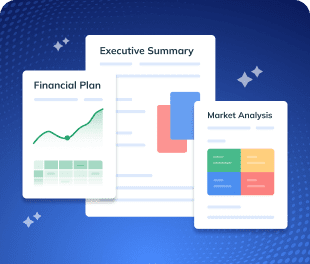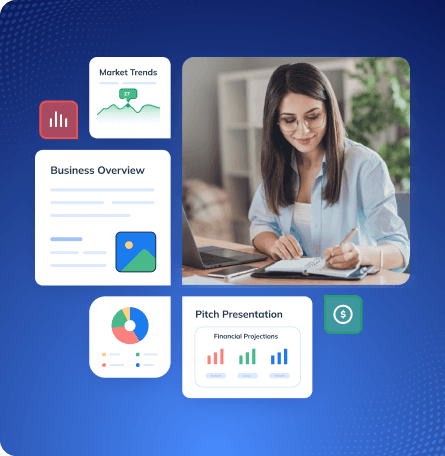Thinking of starting a moving company? It’s not just about lifting heavy stuff and showing up on time.
Behind every smooth move is a ton of planning—schedules to manage, teams to coordinate, and customers counting on you to deliver. That’s where you need a clear plan.
A well-written business plan helps you map out the moving services, understand the customers you’ll target, and secure enough funding to start a moving company.
Wondering how to draft one?
Not to worry! This moving company business plan template will help you structure a plan step by step.
Why do you need a business plan for a moving company?
If you’re running a moving company without a plan, it’s like driving a truck with no GPS. You might get somewhere, but it won’t be fast or smooth.
A business plan shows you where you’re going, how to get there, and how to not run out of cash halfway through.
Here’s how a business plan helps:
👉 Define your niche by locking in your services and ideal customers.
👉 Organize operations by mapping out daily logistics and service workflows.
👉 Set smart pricing that keeps you competitive while covering costs.
👉 Plan team growth by identifying hiring needs.
👉 Manage seasonality with strategies to balance revenue through slow months.
👉 Secure funding with clear financial projections.
Now that you understand why a moving company business plan is useful, let’s take you through how to draft one yourself.
How to draft a successful moving company business plan?
In this guide, we have talked about the steps you’ll need to follow to write a successful moving company business plan.
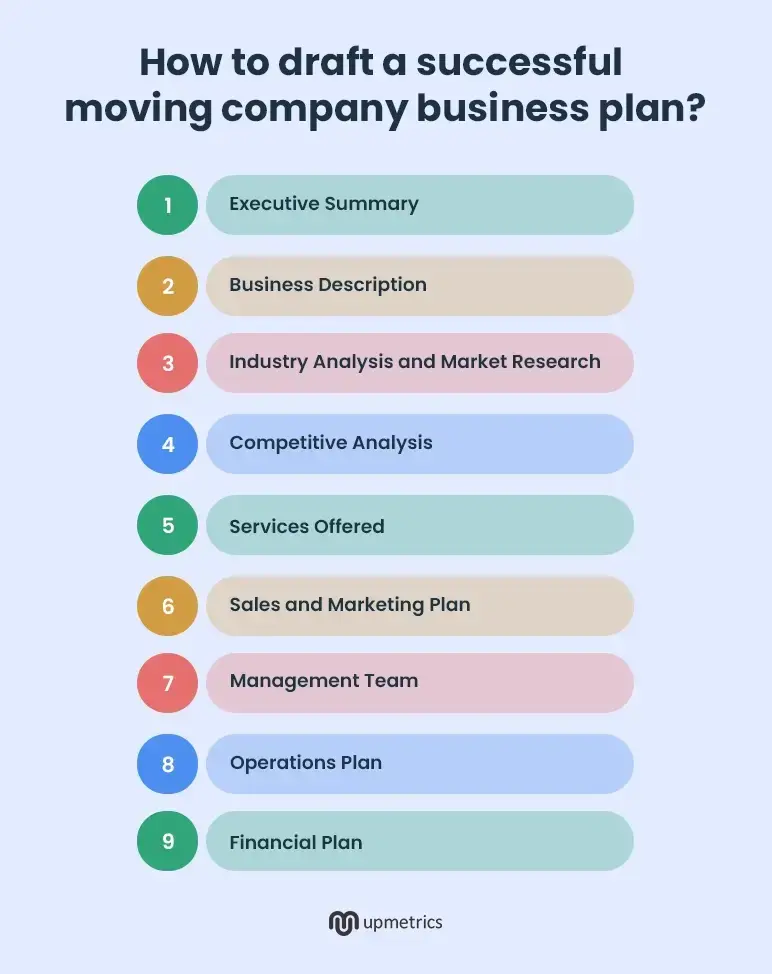
1. Executive Summary
The executive summary is a brief overview of your whole moving company business plan. It summarizes the most important facts about your business—from what services you provide to how you are going to develop.
A properly written executive summary should respond to important questions that an investor or a reader might have, such as:
- What is the core objective of your moving company? Hassle-free relocations? Affordable service?
- The problems your customers are facing and how you’ll solve them. Are they unreliable movers? Are there hidden fees or poor handling issues?
- Will you offer local or long-distance moving? Does it include packing and storage?
- Who are your target customers? Are they homeowners? Renters? Offices? Students?
- What is your marketing plan? Google Ads? Realtor partnerships? Referral programs?
- When will your company be profitable? Mention the financial highlights of your business.
Keep your plan summary within 1–2 pages, and make sure it reflects the full strength of your moving business idea and operations. Once it’s ready, move on to fleshing out the details in the rest of your plan.
Have a look at SwiftHaul Moving Services’s executive summary that you can refer to draft your own:
Business name: SwiftHaul Moving Services
Location: Charlotte, North Carolina
Overview
SwiftHaul Moving Services is one of the most popular local moving companies based in Charlotte, North Carolina. We are experts at delivering efficient and cost-effective moving services on local and long-distance routes. We offer residential and commercial moves, full-service packing and unpacking, furniture assembly, and short-term storage. With a new fleet of well-maintained, GPS-guided trucks and a professionally trained staff, we guarantee a smooth and hassle-free moving experience for all our customers.
Mission Statement
To simplify the moving process by offering dependable, honest, and high-quality services that put customer satisfaction first.
Vision Statement
To become the most trusted and customer-recommended moving company in the southeastern United States, known for professionalism, care, and innovation in moving solutions.
Target Market
Our primary target market is residential homeowners, apartment dwellers, small and medium-sized companies, and college students in the Charlotte area. Our main focus is on families and individuals aged 25–55, plus companies that are making office relocations. A large number of our clients are moving within a city or from one state to another and need convenience, professionalism, and honesty.
Success Factors
- Fully insured and DOT-compliant operations with trained, uniformed movers
- Competitive flat-rate pricing with no hidden fees
- End-to-end service offerings, including packing, transport, storage, and unpacking
- Real-time tracking and customer updates
- Positive reviews and high referral rates from early customers
Marketing Efforts
- A user-friendly website with online booking and instant quote tools
- Active local SEO and Google Ads targeting people moving in or out of Charlotte
- Partnerships with real estate agents, leasing offices, and student housing providers
- Review generation strategy through Google and Yelp
- Branded trucks and uniforms for local visibility
Financial Outlook
In Year 1, SwiftHaul Moving Services expects to complete 400+ moves, generating approximately $300,000 in gross revenue. With lean operations and minimal fixed overhead, we project a 15% net profit margin in the first year. By Year 3, with an expanded fleet and customer base, we aim to cross $750,000 in annual revenue and increase our profit margin to 25%.
| Metric | Year 1 | Year 2 (Est.) | Year 3 |
|---|---|---|---|
| Estimated Moves | 400+ | ~600 | 800+ (goal) |
| Projected Revenue | $300,000 | ~$500,000 | $750,000+ |
| Net Profit Margin | 15% | ~20% (est.) | 25% |
| Estimated Net Profit | $45,000 | ~$100,000 | $187,500+ |
2. Business Description
The business description section provides a clear and structured snapshot of your moving company and explains who you are, what you do, where you’re based, and where you’re headed.
In a successful moving company business plan, this section typically includes:
- Business name & type: Mention the name of your moving business and the type of services you provide
- Company structure: Describe the legal structure of your business. This could be a sole proprietorship, partnership, LLC, or corporation.
- Location: Specify your business location and explain why it was chosen.
- Ownership: List the names of your company’s founders or owners and provide a brief overview of their roles, backgrounds, and shareholding.
- Mission statement: Summarize your moving company’s core objective, values, and customer promise in a few lines.
- Business history: Provide a brief account of when it was established and how it has evolved.
Besides these elements, you can highlight your future goals. Outline your short-term and long-term business goals—expanding your fleet and entering new cities or service areas.
3. Industry Analysis and Market Research
This section provides insight into the moving industry and the specific market you plan to serve. It outlines current industry trends, identifies your potential customers, and highlights the demand for your solution.
The goal of the industry analysis is to present a clear picture of the industry your moving business will operate—and show why it’s the right time to launch or grow your business.
To give a complete view of the industry and market, include the following details:
- A brief overview of the moving industry and its current trends
- Relevant statistics that reflect the industry’s size and seasonal demand
- Target customer segments and their service expectations
- Service gaps or customer pain points in the current market
- Current size and growth trends of the moving industry
- Local housing or rental movement activity that affects moving needs
- Market saturation levels and areas with unmet demands
Try to keep this section clear, specific, and supported by research wherever possible. It lays the groundwork for your marketing, pricing, and service strategy.
4. Competitive Analysis
The competitive analysis section focuses on the other moving companies in your local area and explains how your business will stand out.
Your direct competitors are likely to be other local moving companies offering similar services—local movers, regional operators, long-distance moving companies, and even nationwide brands with a presence in your area.
Indirect competition might include truck rental companies, labor-only services, or customers who prefer to handle the move themselves. This shows that not everyone looking to move will hire a full-service moving company.
Still, your main focus should be on direct competitors, as they serve the same target customers and offer the same types of services.
Analyzing direct competitors will give you a clear view of the competitive landscape and help you figure out where your moving business can have a competitive advantage—whether it’s through better service, more flexibility, or transparent pricing.
It’s also helpful to do a simple SWOT analysis like this for your own business:
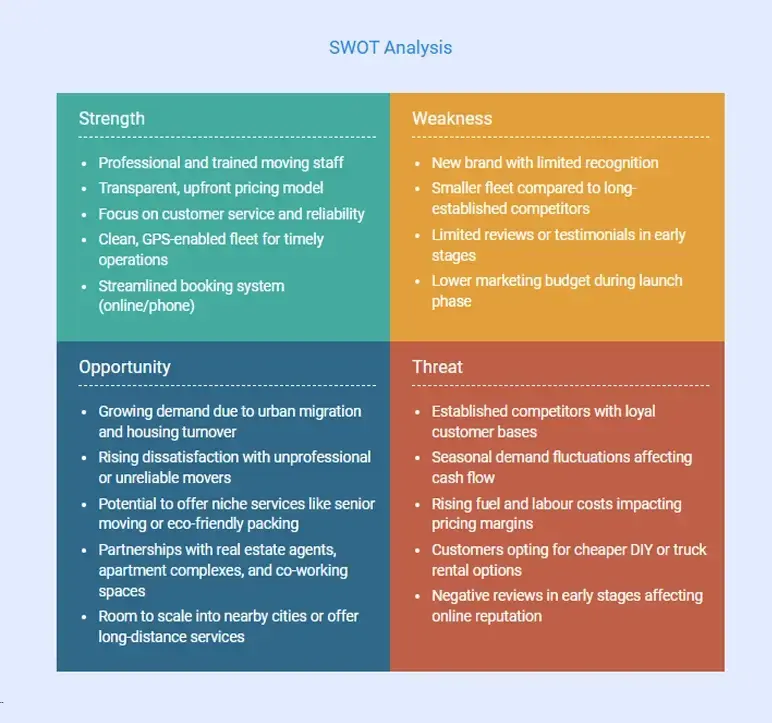
By doing this analysis, you show that you have done thorough research for internal and external factors affecting your moving company.
5. Services Offered
This section outlines the core services your moving business offers. It helps define your business capabilities and highlights what makes your offerings useful and relevant in the current market.
You may offer one or more of the following services:
- Local moving within the same city or area
- Long-distance moving across cities or states
- Office relocations for businesses and workspaces
- Packing and unpacking with supplies included
- Specialty item handling
You can also mention future offerings. Outlining your service offerings clearly helps potential investors, partners, or stakeholders understand the scope of your operations.
6. Sales and Marketing Plan
Writing the sales and marketing plan section means outlining the key approaches the moving business will use to attract potential customers and retain existing ones.
This section focuses on both short-term growth and long-term sustainability through practical, location-specific strategies. To effectively communicate the company’s go-to marketing strategy, include the following components:
Unique Selling Proposition (USP)
Your USPs help you stand out in a competitive moving market. These can be based on the services you offer, how you operate, or the overall experience you provide.
Pricing Strategy
Describe how you plan to price your moving jobs in a way that stays competitive while also being profitable. You might offer tiered pricing based on distance, service level, or move size.
Here’s an example of how you can plan your pricing strategy:
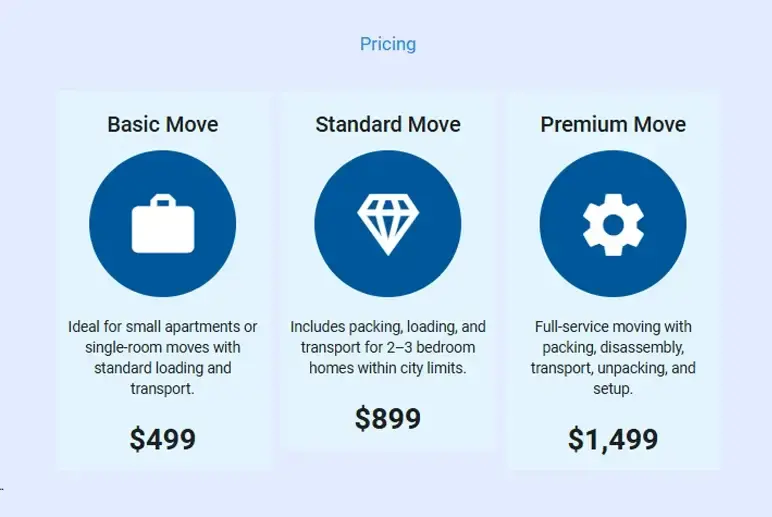
Marketing Channels
Focus on channels you use to reach people at the right time—when they’re actively planning a move. This includes running local Google Ads, posting on social media channels, optimizing your Google Business Profile, and using SEO to appear in searches like “moving services near me” or “moving services in [city].”
Customer Retention
Retaining customers is the key to sustainable growth. Make it easy for satisfied customers to post reviews on Google or Yelp, and reward referrals to leverage word-of-mouth.
7. Management Team
The management section outlines who is responsible for running the business and why they are qualified to do so. This part should introduce the core team members, describe their roles, and explain how their experience supports the company’s success.
You should also explain how responsibilities are divided, even if it’s a small team—mention who handles scheduling, equipment, hiring, or finances.
The purpose of this section is to build confidence that the business is being led by people who understand the work and can guide the company toward stable growth.
8. Operations Plan
The operation plan section provides a detailed look at how the moving business functions on a daily basis and how it will scale over time to meet its broader business goals.
It bridges the gap between strategic goals and execution by detailing how services will be delivered, how resources will be managed, and how the company will maintain consistency in quality and performance.
Here, two distinct sub-sections can be included:
Everyday Short-Term Procedures
This section covers the day-to-day activities required to run the business smoothly. It includes handling customer inquiries, preparing estimates, confirming bookings, assigning crews, and dispatching trucks for scheduled moves.
Milestones
This section includes the long-term goals and performance targets the company aims to achieve. These may include things like “completing 100 booked moves within the first three months” or “expanding from two trucks to a four-truck fleet by the end of Year 1”. These milestones serve as key indicators of growth and operational efficiency.
9. Financial Plan
This section provides an overview of your moving business’s financial projections during the first few years of operation.
It helps you define revenue expectations, cost management, and funding requirements, offering a clearer understanding of the company’s financial foundation and sustainability.
The following are a few key financial documents that you should consider including in your financial plan:
- Revenue Projections
- Expenses and Startup Costs
- Profit & Loss Statement
- Cash Flow Estimates
- Balance Sheet
- Break-even Point
- Funding Needs
In addition, you can discuss risk mitigation strategies to navigate potential challenges effectively. This shows investors that you’ve considered all the aspects and are all set to move your business forward.
Here are some examples of financial projections that you can refer to while drafting your own financial plan:
Income Statement
| Year 1 | Year 2 | Year 3 | |
|---|---|---|---|
| Revenue | |||
| Local Moves | $80,000 | $100,000 | $120,000 |
| Long-Distance Moves | $40,000 | $60,000 | $80,000 |
| Packing Services | $15,000 | $20,000 | $25,000 |
| Storage Services | $10,000 | $12,000 | $15,000 |
| Total Revenue | $145,000 | $192,000 | $240,000 |
| Operating Expenses | |||
| Staff Salaries | $50,000 | $60,000 | $70,000 |
| Fuel & Vehicle Maintenance | $15,000 | $18,000 | $20,000 |
| Packing Supplies | $8,000 | $10,000 | $12,000 |
| Marketing & Advertising | $6,000 | $7,000 | $8,000 |
| Insurance | $3,000 | $3,500 | $4,000 |
| Office Rent & Utilities | $10,000 | $10,500 | $11,000 |
| Total Operating Expenses | $92,000 | $109,000 | $125,000 |
| Net Profit | $53,000 | $83,000 | $115,000 |
Cash Flow Statement
| Category | Year 1 | Year 2 | Year 3 |
|---|---|---|---|
| Cash Inflows | |||
| Cash from Sales/Services | $140,000 | $185,000 | $235,000 |
| Loan/Investment Inflows | $20,000 | $5,000 | — |
| Total Cash Inflows | $160,000 | $190,000 | $235,000 |
| Cash Outflows | |||
| Operating Expenses | $92,000 | $109,000 | $125,000 |
| Loan Repayments | $6,000 | $6,000 | $6,000 |
| Equipment Purchases | $8,000 | $5,000 | $5,000 |
| Taxes | $3,000 | $5,500 | $9,000 |
| Total Cash Outflows | $109,000 | $125,500 | $145,000 |
| Net Cash Flow | $51,000 | $64,500 | $90,000 |
| Opening Cash Balance | — | $51,000 | $115,500 |
| Closing Cash Balance | $51,000 | $115,500 | $205,500 |
Balance Sheet
| Category | Year 1 | Year 2 | Year 3 |
|---|---|---|---|
| Assets | |||
| Cash & Bank | $15,000 | $30,000 | $50,000 |
| Accounts Receivable | $5,000 | $7,000 | $8,500 |
| Office Equipment | $3,000 | $3,000 | $3,500 |
| Software & Tools (Licenses) | $2,000 | $2,500 | $3,500 |
| Total Assets | $25,000 | $42,500 | $64,500 |
| Liabilities | |||
| Accounts Payable | $2,500 | $3,000 | $3,500 |
| Short-Term Loan | $5,000 | $4,000 | $2,500 |
| Taxes Payable | $5,250 | $6,405 | $8,250 |
| Total Liabilities | $12,750 | $13,405 | $14,250 |
| Equity | |||
| Owner’s Equity | $10,000 | $10,000 | $10,000 |
| Retained Earnings | $2,250 | $19,095 | $40,250 |
| Total Equity | $12,250 | $29,095 | $50,250 |
| Total Liabilities + Equity | $25,000 | $42,500 | $64,500 |
Download a free moving company business plan template
Ready to start writing a moving company business plan from scratch but need extra assistance with the same? No worries; you’re in the right place. Download our free moving company business plan PDF to get started.
This free moving company business plan example is designed to guide you through each section of your plan. You can easily customize it to reflect your services and goals. Simply update your business details, and you’ll have a solid plan ready to start a moving company.
The Quickest Way to turn a Business Idea into a Business Plan
Fill-in-the-blanks and automatic financials make it easy.
Summary
You’ve now got a clear breakdown of what goes into a moving company business plan—plus a ready-to-use template to help you get started.
With this structure in place, turning your ideas into a practical, goal-driven plan should feel a lot more doable.
But if you’re short on time or want a faster way to create a polished, investor-ready business plan, try using Upmetrics now.
It’s an AI-powered business planning platform that takes the guesswork out of planning and helps you build a professional plan catered to your moving business in just a few clicks.
